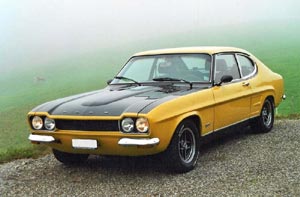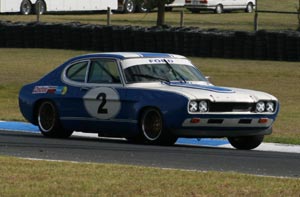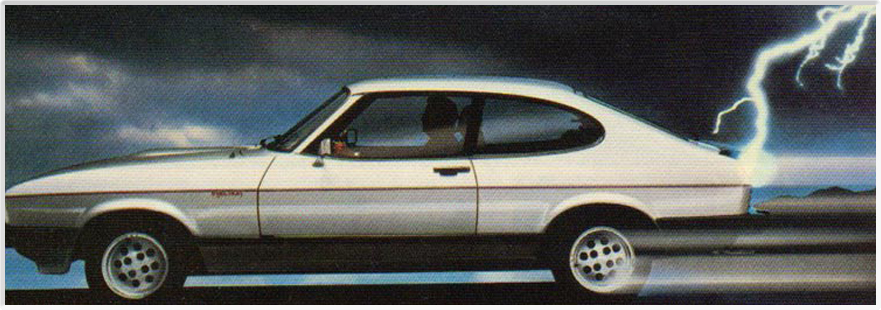
 Club Update Club Update |
 Our next gathering is scheduled for Tuesday, 21st January, 2025, at the Matthew Flinders Hotel, Dinner from 6pm. Our next gathering is scheduled for Tuesday, 21st January, 2025, at the Matthew Flinders Hotel, Dinner from 6pm. |
 Note: Updates are also posted on our Club Facebook page at Capri Car Club Note: Updates are also posted on our Club Facebook page at Capri Car Club |

| Ford Capri Mk1 RS2600 |
|
The first Capri RS2600's were built in March 1970 these being 50 lightweight models for homologation purposes. Often referred to as Plastikbombes, they were fitted with glass fibre doors, bonnet and boot lid along with Perspex sliding side windows and thinner glass even the number of coats of paint was reduced in order to achieve a weight of 900kg for racing, these particular cars also made do without heaters or carpets they were not fitted with fuel injection but did have the long throw crankshaft to give over 2.6 litres required for competition.
During March 1970 the RS2600 made its debut at the Swiss Motor Show albeit with a mock up fuel injection system, September 1970 saw the first fuel injected RS2600 leave the Niehl assembly line these cars were recognisable having no bumpers 2 vents in the front panel and sporting Richard Grant road wheels (the lightweight models used minilites), a pair of rectangular wing badges (same style as the Mk1 RS Escorts) reading RS2600 and an RS roundel on the O/S of the boot lid. These cars did have the front cross member redrilled for negative camber and were fitted with up rated brake pads and linings supplied by Ferodo, competition front springs, single leaf rear springs and bilsteins all round. Internally, as with the lightweight models Scheel sports seats were used but these were now reclining (lightweight models had fixed backseats) and rear seats were bench designed trimmed in the same heavy cord material, a Springall steering wheel was used but no centre console, which were widely used in the Mk1 Capri's. October 1971 saw the first major change with the introduction of the Granada gearbox and the revised rear axle ratio from 3.22:1 to 3.09:1 allowing nearly 22mph per 1,000 rpm as opposed to the earlier 20mph per 1,000 rpm, at this time the unique hub and vented disc which was designed for the 3 litre Cortina was also used. Externally the RS2600 gained chrome quarter bumpers all around, the front bumpers incorporating the indicators, but the two vents in the front panel were now deleted, wheels were now the RS 4 Spoke items similar design to the Mk1 RS Escorts but 6 inches in width, these cars as with the earlier one were fitted with twin cibie headlamps. The paint finish as with the earlier cars was the same style as the German GT cars where the bonnet, engine bay, wing tops, screen pillars and tops of doors fading out at the rear quarter widows would be Satin Black the rest of the car being any other colour in the current Ford range. One known option was the capri racing colours, i.e. early cars could have been ordered silver/ blue whilst later cars white/blue. September 1972 saw the final changes to the RS2600 in line with the introduction of the Facelift Mk1 Capri along with all of the mainstream changes to the facelift Capri the RS now featured a Decal set comprising of one around the power bulge with the word "Injection" either side of the bulge at the rear a roundel on the fuel filler cap reading RS 2600 Injection another in the same position on the N/S rear quarter and one running along the lower boot edge and around the back edges of the rear quarters with injection cut out on the N/S and RS on the O/S next to the Capri badge decals were available in white, black and blue. Bumpers were still quarter width at the front but now full width at the rear now finished in Black. The N/S front bumper iron incorporating a towing eye, spot lamp brackets were also fitted up front these helped support the quarter bumpers, headlamps were now Hella units whilst bezels were GXL type (earlier models used the federal type), wing badges were now the shield type reading 2600V6. Inside the car the Facelift RS2600 had the flat 3-spoke steering wheel, a centre console for the first time and a map reading lamp, seats remained the same up front but the rears were cloth over the whole of the face and still contoured items. Mechanically things were pretty much the same except for the Kugelfischer Injection pump this was now the C1 type with different injectors, fuel lines and throttle body, earlier cars used the B1 pump along with injectors that could be dismantled and rebuilt (the later injectors could not be repaired) there was a short period from approx June 1972 when pre-facelift cars were also fitted with the later C1 system it appears these were the cars that built at Saarlouis these cars are recognisable by there Chassis Numbers cars built at Niehl start GAEC whilst cars built at Saarlouis start GCEC. The easiest way to distinguish the two different types of fuel systems is the B1 system has the cold start injector at the front of the Plenum Chamber the C1 has the cold start injector in the throttle body at the O/S of the Plenum Chamber, one thing to note genuine RS2600 engine numbers start with the letters QZ. There were many options available on the RS2600 including an LSD, opening rear quarter windows, sunroof, radio, head restraints and spot lamps. Performance figures for the RS2600 were very impressive with 2,637cc producing 150 bhp at 5,800rpm and 159lb.ft of torque @ 4,000 rpm this was sufficient to propel the RS2600 from 0-62mph in 8.6 secs and on to a top speed of 126mph. Thanks to rscapris.com for the information found on this page.
|

 |












